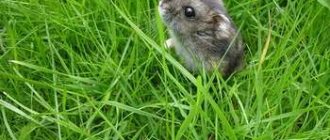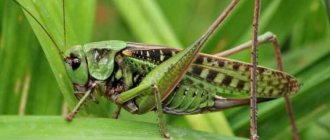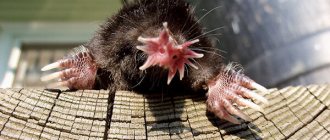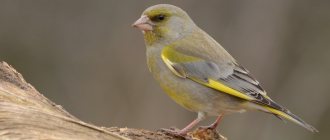- Wild animals
- >>
- Mammals
There are a lot of animals in nature that know how to dig tunnels underground. However, the most famous digger, known since childhood, is the mole . This mammal spends most of its life underground, which is facilitated by the special body structure and physical capabilities of the mole. This is a unique creation of nature, which brings both unconditional benefit and quite serious harm to humans.
Origin of the species and description
Photo: Mole
The mole is a very small animal with tiny eyes and strong paws that have the ability to dig through long underground passages. The eyes of some mole species are securely hidden under the skin. Moles do not have ears; they have smooth, very soft fur. The coat color is usually black, but there are also animals with a dark gray “fur coat”.
Moles are classified as insectivores, which belong to the broad class of mammals. They are part of the mole family - lat. Talpidae. The animals got their name for a reason. Literally, the word “mole” means “digger.” The name comes from the word “dig, dig.”
Video: Mole
These underground inhabitants can make passages hundreds of meters long. Under the soil, the animal arranges a sleeping place for itself and makes special corridors in which it hunts. Moles prefer to spend the night on moss, grass or leaves. They are quite intelligent animals, so a secret passage is always provided in the “bedroom” for retreat in case of danger. The underground passage is covered with bedding.
Interesting fact: Constant movement through narrow earthen passages is reflected in the appearance of the animal. Gradually, the mole wears off its fur, remaining completely bald. However, nature has provided for everything - moles grow a new “coat” 3-4 times a year.
Moles also equip their homes with additional passages to a water source. Some animals create their own underground wells. Wells fill with water during heavy rains. In winter, such animals prefer to hide deep in the ground. At great depths, the earth remains warm and does not freeze.
How to get rid of moles on a plot or in a garden?
To fight moles in your summer cottage, you don’t need to destroy their passages, because the animals will simply build new ones. To prevent animals from causing disturbance, they are destroyed, captured or scared away. There are many ways to do this. Gardeners often practice exterminating moles using the following means:
- using all kinds of traps,
- using poisons
- pitting dogs and cats,
- flooding the mole holes with water.
Traps for moles.
You can make mole traps with your own hands, but it is better to purchase them in a store to avoid injury when working with metal parts. Traps and traps are based on different operating principles of their mechanisms:
- Traps that act like spring mousetraps , that is, they crush the victim and break the vertebrae. This device is not inferior in efficiency to others, the only difficulty lies in its installation. These mole traps are placed in twos, in different directions. They need to be installed and masked so that the pressing part does not cling to the arch of the stroke when the mechanism is activated.
- A plunger or harpoon trap is quite easily installed on top of the passage. When a mole touches a guardhouse located in a tunnel, sharp spokes pierce the ground and pierce the animal.
- The scissor trap squeezes the animal from the sides, acting on the principle of scissors. To install, a molehill is dug up, the trap is placed at the bottom of the passage and covered with earth.
- A loop trap is a wire trap for a mole in the form of a loop, which is placed inside the mole passage. When triggered, the mechanism strangles the animal in the loop as it crawls through it.
There are various versions of the above traps in more or less expensive versions, and there are even more homemade traps. But we must take into account that not every person is capable of killing a mole, especially in such a barbaric way.
- Live traps or tunnel traps . If you want to get rid of moles in your dacha in a simple way, but without destroying the animal, you can use other devices - live traps, which help catch the mole. You can make them yourself using cans, plastic bottles and other cylindrical objects, or purchase them at the store. The principle of a live trap is that, once inside the body, the animal cannot get out, since the holes are closed with valves that do not have a reverse action. The animal remains alive and just needs to be taken away from its area and released. Such traps need to be checked regularly so that the mole inside does not die of starvation.
Moles often dig tunnels through which they reach their prey only once. To install mole traps, you need to determine which passages the animals use repeatedly, otherwise your efforts will be wasted and you won’t be able to catch the mole. These passages are deeper, and the ground in them is more compacted.
Taken from the site: www.ozon.ru
Poison for moles.
Another remedy for moles in the country is poison. But this method of getting rid of animals is not only inhumane, but also unsafe for humans and their environment. Under no circumstances should poisons be used in areas where children play! The poison may accidentally come into contact with the skin and cause harm to health. Pets can also accidentally ingest poison. In addition, toxic substances can be destructive for plants in a summer cottage, which will cause irreparable damage to the plantings.
Fighting moles with water.
Fighting moles on a site by flooding their holes is an old and not very effective method. An abundance of moisture, which the animal does not like, is not good for plants either. You will have to pour too much water, but the animals will still return to the area after it dries out.
Catching moles with dogs and cats.
Setting dogs on small animals is a somewhat exotic and ineffective method that will not help the mass expulsion of moles.
Mole repellers.
It is more humane to permanently get rid of moles in the garden by scaring them away. Below are the means that quite effectively help fight moles in the country:
- Noise installations, or noisemakers (turntables made from tin cans, rattles, empty bottles buried in the ground). The fact is that garden moles really do not like various noises and vibrations. Based on this, all sorts of devices that make sounds have been invented. You can make them yourself: make a pinwheel from plastic bottles by cutting holes in it and bending it into blades. It is mounted on a metal pin, which is stuck into the ground to a depth of about 20 cm and transmits the sound of a rattling bottle into it,
- you can also put a tin can on the pin, which will rattle when the wind blows and transmit noise to the ground along the metal pin on which it is located,
- a glass bottle is buried in the ground at an angle to use the howling wind against moles,
- some even bury jars with alarm clocks set or scatter plastic bottles around the area that rattle when they touch,
- Loud music, lawn mowers and other farm implements will also repel moles.
- Ultrasonic mole repeller.
Ultrasonic repellers, conventional or solar-powered, are devices that produce sounds inaudible to the human ear and produce vibrations in the soil. These are very effective and efficient mole repellents that produce results some time after their installation. Unlike noise devices, they do not irritate people with sounds, look aesthetically pleasing and are easy to use. You just need to stick them into the ground and turn them on. The range of action of good electronic repellers reaches 15-25 meters. In addition, they help remove not only moles from the dacha, but also mice and rats.
- Flavors.
You can put special tablets or anti-mole balls flavored with essential oils into mole passages. It is believed that animals are repelled by garlic, hemp, herring heads, rags or tow soaked in kerosene, tar, solvent and other strong-smelling technical liquids. Such “tags” need to be placed in different parts of the area so that the mole is guaranteed to stumble upon them. Technical fluids are not the best remedy, given the fact that there are various plantings on the summer cottage. But balls with essential oils do not contain toxic substances at all, are harmless to insects and last quite a long time. True, after heavy rain they lose their properties.
- Plants from moles.
Another folk remedy for moles in the country is to scare away the animals with the unpleasant aroma of certain plants. Moles do not like the smell of plants such as legumes (beans, peas, broad beans), marigolds, narcissus, Siberian bluegrass, imperial hazel grouse, spurge, castor beans, lavender, calendula, black root, kozelets, garlic, onions (onions, leeks, shallots, chives, decorative alliums).
Imperial hazel grouse
- Burying pieces of metal and crushed animal bones in the ground.
Other methods are also used to repel moles, in particular, placing pieces of glass, metal, and bones in the ground. In this case, you must be careful not to injure yourself by bumping into such an obstacle.
- Mole net (underground barrier).
This is the most expensive and labor-intensive, but at the same time very effective method of controlling moles in a summer cottage. This means fencing the entire area from which you want to drive out moles with metal or plastic fine mesh. You can use other materials: slate, tin, concrete, etc. Such a barrier must be buried to a depth of at least 80 cm. It happens that it is necessary to protect lawns and flower beds from moles not only in personal garden plots, but also, for example, in public parks. In this case, the mesh is buried shallowly, but in a horizontal position, under the protected area. Also, mole netting can be spread on the prepared soil before laying the finished lawn. Thus, the mole simply will not be able to make holes in it.
Appearance and features
Photo: Animal mole
The main feature of these small animals is the lack of vision. If for humans and other animals the lack of vision is a serious defect, then for moles it is considered the norm and even a necessity. Having normal eyes, these animals simply would not be able to spend almost their entire lives underground. Moles have eyes, but in most species they are additionally protected by a layer of skin.
Not only the organs of vision are completely adapted to underground life. The hearing organs are also adapted to it. Moles do not have ears. This is also not just provided by nature. If there were ears, then too high pressure would form in them. Such pressure would not allow the animal to be in the soil.
Diggers have fur that is very pleasant to the touch. It also has some features that differ from the fur of other animals. The mole fur covering can be easily folded in different directions. This property allows animals to slip into narrow underground tunnels without problems. The color of the fur is usually black, brown or dark gray.
The appearance of moles can be characterized by the following parameters:
- The total length of the animal is about sixteen centimeters. Of this, the body occupies approximately seven centimeters, and the rest is the length of the head and tail.
- The average weight of the animal is fifteen grams. However, representatives of the family of larger sizes are known. For example, scientists came across the Ussuri mogera, whose length is twenty-one centimeters.
- The body shape of this mammal is bar-shaped. Moles have a tiny head and an almost invisible neck. The auricles of most members of the family are undeveloped, while in others they are very small and covered with hair. Animals also have a nose in the form of a small proboscis. It contains sensitive hairs. The nostrils are directed forward.
- The mammal's paws have five toes. They are the main tool for digging long tunnels. The paws are strong and have claws. The hands resemble shovels; they are turned with the palms facing outward. The mole digs tunnels with its front legs, while its hind legs are less strong. They are very thin and resemble the paws of rats.
Habitat
The mole spends almost its entire life in underground burrows, but not every soil is suitable for it. The animal carefully chooses its place. It prefers moist and loose soil. Another habitat is simply not suitable for the mole: it will not be able to break solid lumps of earth.
But sometimes soil mounds are found in fields and meadows. The mammal usually throws excess soil upward. Mole rats can be active both at night and during the day. They don't care what time of day it is, since their eyes don't distinguish between darkness and light well.
The biological rhythms of the mole are different from other animals. The mammal alternates periods of activity and rest. It prefers to work for four hours and then sleep for three. It is not easy for a mole to move underground, so it does not make long movements. Only on hot summer days does the animal break through passages to reservoirs.
Mammals do not like to be in the company of their own kind. These are loners, so they are ready to defend their chosen areas. Moles have a difficult character and often show aggression. If they had to share the land with neighbors, then the passages are dug so that they do not intersect with the paths of another individual. But if one animal dies, the second tries to quickly occupy its territory. As a mark, moles secrete a special substance - a secretion with a pungent odor.
Mammals do not hibernate in winter. The inhabitants of the underworld prefer to spend their time differently during the cold season. They dig deep holes and fill them with supplies. Only underground can moles spend the winter while remaining safe. If they get to the surface, they will become prey for eagle owls, foxes and martens.
Where does the mole live?
Photo: Soil animal mole
Representatives of the mole family are widespread. They live throughout Eurasia and North America. In South America, moles are completely absent. Scientists have concluded that these animals settled in North America when it was separated from the South by the Strait. Moles live in especially large numbers in Russia, Belarus, Poland, Ukraine, Georgia, and Moldova.
In particular, four species of moles live in Russia:
- Blind. It is distributed from Ciscaucasia to Transcaucasia. Representatives of this species can often be found in Turkey and even in Northern Iran. The animal lives in mountains, alpine meadows, and is sometimes found in forest landscapes. To live, blind moles choose loose, moist soils. Sometimes these animals live together with the Caucasian species;
- Caucasian. It settles in the central, western parts of the Caucasus, and is found in some areas of Turkey, which are adjacent to the shores of the Black Sea. Caucasian moles live mainly in deciduous forests, but in small numbers they are found in mountain meadow biotopes. In search of food, such animals can go to a depth of up to one meter. The main passages are located quite close to the surface - at a distance of five centimeters;
- Altaic. It has a uniform coat color, the fur on the belly is matte. The appearance of Altai moles is completely consistent with moles. The body of the animal is quite massive and round;
- Ordinary. This is the group of the most common moles. Its representatives can be found in various landscapes: from forests to mountains.
For a normal life and reproduction, moles need special conditions. For this reason, they choose areas with moist soil. It is most suitable for digging tunnels. The terrain of the area can be almost anything. The animals prefer a moderate climate.
What does a mole eat?
Photo: Mole insectivore
Moles, although small, are quite voracious animals. They are active around the clock, but hunt more often at dusk. Animals have a high metabolism. In summer, moles eat in large quantities, and in winter, the diet and amount eaten decrease slightly. Animals prefer to live and hunt alone, but sometimes there are also representatives of the family living in groups.
The main part of the mole's diet is earthworms. Mammals eat them in the summer and store them for the winter, biting off the heads of the worms, paralyzing them. Moles also eat larvae of earthworms, larvae of click beetles, May beetles and other varieties of beetles. Flies, caterpillars, and slugs often end up in mole food.
The largest representatives of the mole family, mogers, prefer to feed on butterfly caterpillars. Star-nosed moths eat small aquatic inhabitants. They can feast on crustaceans, small fish and insects. American shrews include plant foods in their diet.
Interesting fact: A tiny mole can eat a huge amount of food in a day. The animal absorbs food, the weight of which is equal to the weight of the animal itself. Also, these mammals are quite thrifty. A mole can store about two kilograms of food in its nest for a rainy day.
In one day, the number of meals can reach six times. After each hearty meal, the mole falls asleep sweetly. Sleep duration is usually four hours. It is during this period of time that the food has time to be completely digested. The animals are not used to going hungry. They can live no longer than seventeen hours without food.
To find a fresh treat. moles do not have to dig new passages every time. They find food in old tunnels into which the worms crawl on their own. Worms are attracted due to the warmth and special smell of moles. In winter, members of the family also do not have to starve. Earthworms are no less active. They are able to make moves even in frozen ground.
Beneficial features
The European mole has useful traits. They are expressed in the fact that the animal was previously an object of the fur trade. The mammal has beautiful and durable fur. At the beginning of the last century, moles were hunted for their valuable skins. But the massive catch led to the fact that the animal began to need protection. In 1928 alone, about 20 million skins were harvested.
In the Soviet Union, mole fur clothing became popular in the 1980s. But today in Russia mammals are not hunted, which is why their population has grown. Their numbers also increase due to mild winters, the construction of greenhouses, and the care of lawns and flower beds .
Moles improve the condition of the soil. They make it loose and saturate it with oxygen, which can save the earth from the formation of swamps. Animals destroy pests because they feed on them. Moles eat chafers, mole crickets, and insect larvae.
Features of character and lifestyle
Photo: Common mole
Almost the entire life of a mole is spent in complete darkness. They build incredible labyrinths in which they then live and hunt. Labyrinths can lie at different depths in the ground. Digging takes an animal a lot of time. Above the passages, which are located close to the surface of the earth, you can always notice a characteristic roller. The depth of the labyrinths depends on the type of soil. If it is loose and wet, the passages are made at a shallow depth; in dry soil, channels are dug at a depth of twenty centimeters.
The deepest tunnels are dug by animals under forest paths. Nests are also located at great depths. On average, females build nests at a depth of 1.5 meters. The nest is carefully lined with grass and leaves. Animals can from time to time roam around the area where they live. In the summer they descend to the lowlands, in the spring - to the hills. In spring, male moles can expand their territory several times. This is due to the search for a female for reproduction.
Moles have a contradictory character. They are grumpy and quarrelsome. Very rarely animals live in a group. They unite in pairs only when the time comes for the mating season. Moles show friendliness only at a young age. Young individuals caress each other. But with the process of growing up, not the best qualities begin to appear - grumpiness, pugnacity.
Adults often start fights if they meet each other on the way. They are capable of mercilessly biting to pieces an opponent. It is not surprising that in captivity, representatives of the family eat the meat of their relatives with great appetite. Also, moles do not have empathy. If their neighbor gets into trouble or dies, there will be no help. Moles quickly occupy the tunnels of the dead animal and use it for their own purposes.
Burrow construction
The mole spends most of its life underground. Only to develop a new area does it come to the surface. The animal digs two types of tunnels:
- veins;
- search engines
The first ones are also called nests; the mammal rests and hides in them during the cold season. They lie at a depth of 10−90 cm, and their diameter is only 5 cm. Closer to the surface, the mole makes search passages. He digs them so that earthworms and other underground invertebrates live nearby. The network is extensive, it can occupy significant areas - hundreds of square meters. Moles leave traces behind them: soil rollers that appear due to the swollen arches of passages.
The animal digs the ground with its front paws, and rests against the already compacted walls of the hole with its hind paws. At a depth of 10 cm, the mammal can no longer raise its head, so it throws the soil to the surface.
These heaps are called molehills; they reach 15–25 cm in height and up to 1 m in diameter. They are usually gathered in small groups. Molehills are the only sign of the presence of moles on the site that a person can detect.
Social structure and reproduction
Photo: Mole wild animal
Representatives of the mole family reproduce once a year.
However, the number of moles and the breeding season differs among different species:
- The Siberian breeds in June. However, offspring appear only a year later, in the spring. On average, pregnancy lasts about two hundred and seventy days. At one time, the female gives birth to no more than six cubs;
- The Caucasian prefers to mate in February, and moles appear in March. No more than three cubs are produced at a time. The brood becomes independent within forty days after birth. Representatives of this species increase their numbers very quickly, because the offspring appear very deep underground. He is in no danger;
- The European mate in the spring - during March and April. Forty days after meeting the male, the female gives birth to moles - about nine individuals at a time. The weight of one cub, as a rule, does not exceed two grams;
- Blind. It breeds in February; the gestation period for the young is one month. The female gives birth to about five individuals at a time.
Interesting fact: The lifespan of a mole depends on its species. On average, members of the family live from three to five years.
Exposure to weather conditions
The main climatic enemies that affect the life expectancy of moles are:
- Drought that destroys vegetation, causing the death of invertebrates and other insects on which they feed.
- Frosts, or rather, freezing of the soil. If the soil becomes too hard, moles lose the ability to move because they cannot dig. And the food in their pantries can freeze and become inedible.
- Floods caused by rivers overflowing due to heavy and frequent rainfall or large amounts of ice and snow. Flooded burrows force animals to rise to the surface, and if they do not drown, they often become victims of land-based predators.
It is because of such “cataclysms” (on the scale of moles) that their average life expectancy is 3-4 years.
Natural enemies of moles
Photo: Mole underground animal
Representatives of the mole family have few natural enemies. They can only be harmed by birds of prey, wild boars, badgers, and martens. Such animals often die from an arid climate, too much moisture, or at the hands of humans themselves. People kill animals either intentionally or accidentally. Some are trying to catch the mole and domesticate it. But such an undertaking also ends in the death of the animal.
Also, a small number of adult individuals die from the paws of their relatives. Adult moles are quarrelsome and pugnacious, so fights between them are not uncommon. Fights usually end with the death of one of the fighters.
Interesting fact: Moles have no natural enemies, only underground. If the animal does not climb to the surface of the earth, then nothing threatens it.
Sense organs
The eyes are small, very poorly developed and almost completely covered with skin. The mole has no ears. The auditory openings are also covered with skin. But the animal’s hearing is remarkably developed.
Which sense organs are better developed in a mole? The frequency sound conductivity of the soil is available to it. The sense of smell is well developed. By smell, he finds food in the ground.
Tactile hairs are distributed throughout the body. Thanks to them, he senses worms located 50-70 cm away from him.
Also an integral part is a 2-centimeter tail, which is covered with hairs. When the mole raises its tail, it feels the ceiling of the dug tunnel. If he does not feel the ground, he returns to his hole.











